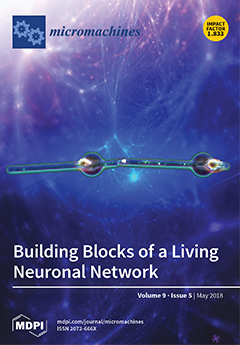Transmembrane pressure across the glomerular filter barrier may underlie renal failure. However, studies of renal failure have been difficult owing to a lack of in vitro models to capture the transmembrane pressure in a controlled approach. Here we report a microfluidic platform of
[...] Read more.
Transmembrane pressure across the glomerular filter barrier may underlie renal failure. However, studies of renal failure have been difficult owing to a lack of in vitro models to capture the transmembrane pressure in a controlled approach. Here we report a microfluidic platform of podocyte culture to investigate transmembrane pressure induced glomerular leakage. Podocytes, the glomerular epithelial cells essential for filtration function, were cultivated on a porous membrane supplied with transmembrane pressure Δ
P. An anodic aluminum oxide membrane with collagen coating was used as the porous membrane, and the filtration function was evaluated using dextrans of different sizes. The results show that dextran in 20 kDa and 70 kDa can penetrate the podocyte membrane, whereas dextran in 500 kDa was blocked until Δ
P ≥ 60 mmHg, which resembles the filtration function when Δ
P was in the range of a healthy kidney (Δ
P < 60 mmHg) as well as the hypertension-induced glomerular leakage (Δ
P ≥ 60 mmHg). Additionally, analysis showed that synaptopodin and actin were also downregulated when Δ
P > 30 mmHg, indicating that the dysfunction of renal filtration is correlated with the reduction of synaptopodin expression and disorganized actin cytoskeleton. Taking together, our microfluidic platform enables the investigation of transmembrane pressure in glomerular filter membrane, with potential implications for drug development in the future.
Full article






